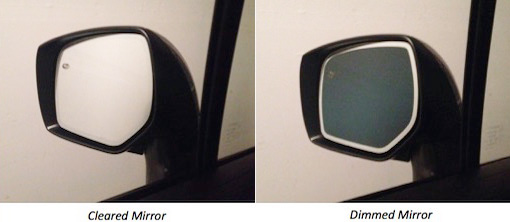Auto-Dimming Mirrors
- Basic Description
-
Auto-dimming mirrors, also called self-dimming mirrors, can automatically dim and clear according to the ambient and incident light levels. Research shows that headlight glare from cars traveling behind you reflected by your rear-view or side-view mirrors can obstruct your vision and contribute to fatigue while driving at night. This glare can also slow your reaction time and increase the time required to stop the car in emergency situations.

Auto-dimming mirrors employ an ambient light sensor and a rear-facing glare sensor. In low ambient light conditions, a microcontroller uses output from the glare sensor to determine how much the mirror should be dimmed. The microcontroller applies a voltage to an electrochromic material held between two pieces of glass in the mirror. The electrochromic material dims the mirror in proportion to the applied voltage.

A disadvantage of auto-dimming mirrors compared to manually adjustable mirrors with two reflective surfaces is that auto-dimming mirrors require power and cannot simply be glued to a standard windshield with no wire connections. However, since an auto-dimming rear-view mirror stays in a fixed position while driving, it is possible to display other information, such as time, temperature or direction of travel, in the mirror housing.
- Sensors
- Ambient light sensor, glare sensor
- Actuators
- Electrochromic material in the mirror
- Data Communications
- Usually none
- Manufacturers
-
ABEO, CIPA, Gentex, Hamamatsu, Magna, Miortech, Murakami, SL Corporation, SMR, Tokai Rika
- For More Information
- [1] Electrochromism, Wikipedia.
- [2] Gentex Auto-Dimming Mirrors, YouTube, Nov. 1, 2010.
- [3] Toyota Accessories Auto Dimming Rear View Mirror, YouTube, July 4, 2014.
- [4] How Do Electrochromatic Windows Work?, Chris Woodford, Explainthatstuff.com, Sep. 17, 2014.
|

